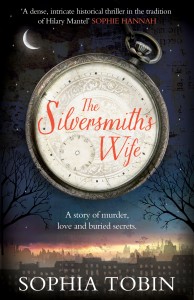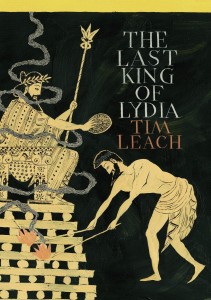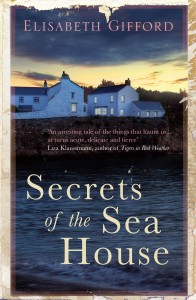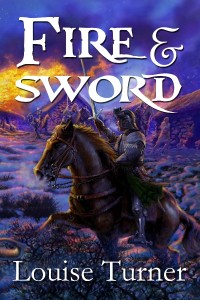New Voices: Elisabeth Gifford, Tim Leach, Sophia Tobin & Louise Turner
by Myfanwy Cook
Elisabeth Gifford, Tim Leach, Sophia Tobin, and Louise Turner have created imaginative debut historical novels foreshadowing a year of memorable reading ahead!
Tim Leach was prompted to write his debut novel, The Last King of Lydia (Atlantic), because: “I wanted to know how the story would end, and so I had to write it myself.” As he explains, “It’s always the untold stories, the unfinished stories that call to a writer from the pages of history. In my case, I found the inspiration for my first novel at the very beginning of recorded history, in the works of the ancient Greek writer Herodotus.
“This is a man known both as the ‘Father of History’ and as the ‘Father of Lies,’ which gives a fair indication of his reliability as a source text. (It’s this historical ambiguity, of course, that makes him so appealing for a novelist.) In the first pages of Herodotus, when he’s at perhaps his least reliable, he tells the story of Croesus, king of Lydia.
“Inventor of the gold coin and ruler of a great empire, Croesus famously debated the nature of happiness with the Greek philosopher and sage Solon. Croesus claimed that he was both the happiest and the richest man alive; Solon countered that one could not know if one’s life had been happy until you could judge all of it (essentially, when you were dead). Until then, you weren’t happy, just lucky. Croesus ignored the philosopher, went to war with the rising power of Persia (today better known as Iran), and lost. Condemned to die by fire, he was reprieved at the last moment and taken into slavery by his conqueror.
“And that’s it. In the source material at least, that’s where the story ends. Herodotus moves on, leaving Croesus alive but in chains, his tale unfinished. But for me, that was where things were just beginning to get interesting – the richest and most powerful man in the world, reduced to slavery. A man who had debated on happiness with ancient philosophers, put in a situation where happiness seemed impossible.
“In its debates on happiness and money, war and empire, it seemed a surprisingly modern tale, despite being over 2000 years old. I wanted to see how Croesus would survive, and if would manage to invent a new meaning for his life.”
For Sophia Tobin, it was silver rather than gold that played an important part in the inspiration for her first novel, published by Simon & Schuster UK. She had: “a real 18th-century silversmith to thank for The Silversmith’s Wife. His name is Thomas Heming, and I first held a piece of silver by him when I was working for a Bond Street antique dealer. As I researched him, my fascination with 18th-century London increased, but the questions I really wanted to ask about him – who he loved, who he hated – could not be answered by the historical sources I found on his life. So I left Thomas behind, and began to think about writing a story with his world as the backdrop. I knew it took a great deal of ambition for him to become a Bond Street silversmith, and there was a frisson of both glamour and danger to the occupation (in the days before a police force, having large amounts of gold and silver in your possession was a risky business). What if my silversmith was not an honourable man, but a very complex character indeed? What if he had many enemies, and at least one of them was prepared to kill him?
“In the winter of 2010, my route to work took me through St James’s Park every morning. As I walked, the characters began to form strongly in my mind, and their stories are steeped in the cold of deep winter. They live in London, 1792, and their drama is played out in Mayfair and the City of London. The names of the streets are familiar – Bond Street and Berkeley Square – but I also wanted to create a sense of how these places might have been two hundred years ago, so that they are both familiar and strange to the reader.
“The Silversmith’s Wife might be a murder mystery, but it’s also about human relationships, the good and the bad. My final inspiration was our emotional lives: I’m fascinated by the workings of our closest relationships, and how different the reality of a marriage can be compared to its surface appearance. So I started thinking about love, betrayal and redemption, and how they would have been experienced by my characters: a night-watchman, a lady’s maid, a silversmith, and a silversmith’s wife.”
Louise Turner, author of Fire and Sword (Hadley Rille Books), was working as an archaeologist when she first began writing. When she was looking for inspiration, she followed the old maxim, “Always write about what you know.” She says: “I started investigating the local history of the area around where I live in the west of Scotland.
“It was one line in a local historical account that hooked me. It referred to John, 1st Lord Sempill, who died at Flodden in 1513. The quote went along the lines of ‘His father died defending the King at Sauchieburn in 1488, and a year later he was made a Lord of Parliament.’ I did some background reading, and discovered that James III was murdered at Sauchieburn. In other words, John Sempill’s father died fighting on the losing side and, soon after, John was made a Lord of Parliament. As someone with a professional interest in the past, and as a writer, too, that contradiction really got me thinking.”
Although local history didn’t shed much light on the plot, by looking further afield she was able, she says, “to thread together the local accounts with the wider political situation, and suddenly it all started to slip into place. As a historian, I could never have justified the connections, but as a novelist, I was free to follow lines of enquiry that blossomed in unexpected and yet very fulfilling ways. It was an adventure from beginning to end – at first, I’d intended to write a biography of John 1st Lord Sempill’s life, but in the end I had a novel which focused on just 18 months of his life.”
Turner’s story of adventure began with historical research at a local level, whereas for Secrets of the Sea House (Atlantic UK / St. Martin’s, as The Sea House) by Elisabeth Gifford, the author “was inspired by a real letter to The Times newspaper in 1809, reporting a mermaid sighting by a Victorian schoolmaster. I was surprised to find that there were several such sightings. In the Hebrides and Ireland there are also persistent legends of Selkies, seal people who transform into humans on land. Certain Hebridean families even claim to be descended from seal people!
“Through Gaelic historian John MacAulay, I discovered that the legends of sea people might well be the only record we have of an ancient tribe of Sea Sami from Arctic Norway who visited the shores of Scotland over thousands of years. They travelled down in Eskimo-style kayaks. When waterlogged, the sealskin kayaks sat just below the surface of the water so that you would see the torso of a man in the sea with a tail-shaped appendage wavering in the water beneath! Once on land the seal skin jacket would be removed. Could this be what lay behind the legends of mermaids and Selkies?
“Victorian historian MacRitchie thought so. It’s hard to prove this theory since, under intense pressure to assimilate into Norwegian culture, the Sea Sami tribe disappeared about 200 years ago. This date coincides with the last reported sightings of mermaids. Their fragile artefacts have now all but vanished; the sea people legends may be the only evidence left that the Vikings were not the only visitors to travel down the sea road from Norway.”
Secrets of the Sea House chronicles 20th-century crofting, and the brutal clearances from the Hebrides. Victorian amateur scientist Alexander Ferguson seeks to find an evolutionary explanation for the a people legends – after all Darwin began his evolutionary studies in Edinburgh, the then centre for radical science – a quest taken up by Ruth a century later, after she discovers what seems to be a mermaid skeleton.
“The narrative is specifically in the form of a traditional mystery story to better convey the power that legends and myths have to contain actual historical events that would otherwise be lost to us, and the power that story has to tell us where we come from, and where we might choose to go.”
Mystery, murder, myth and memories have all been woven into the stories of this inspiring new crop of debut novels given to us to harvest.
About the contributor: MYFANWY COOK admires the creativity of debut novelists and their ability to unearth new stories to delight lovers of historical fiction. Please do email or tweet (twitter.com/MyfanwyCook) about debut novelists who you have enjoyed reading.
______________________________________________
Published in Historical Novels Review | Issue 67, February 2014










